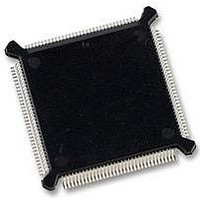MC68331CEH25 Freescale Semiconductor, MC68331CEH25 Datasheet - Page 87

MC68331CEH25
Manufacturer Part Number
MC68331CEH25
Description
IC MCU 32BIT 25MHZ 132-PQFP
Manufacturer
Freescale Semiconductor
Series
M683xxr
Specifications of MC68331CEH25
Core Processor
CPU32
Core Size
32-Bit
Speed
25MHz
Connectivity
EBI/EMI, SCI, SPI, UART/USART
Peripherals
POR, PWM, WDT
Number Of I /o
18
Program Memory Type
ROMless
Voltage - Supply (vcc/vdd)
4.5 V ~ 5.5 V
Oscillator Type
Internal
Operating Temperature
-40°C ~ 85°C
Package / Case
132-QFP
Controller Family/series
68K
No. Of I/o's
18
Cpu Speed
25MHz
No. Of Timers
1
Embedded Interface Type
QSPI, SCI, UART
No. Of Pwm Channels
2
Digital Ic Case Style
PQFP
Rohs Compliant
Yes
Processor Series
M683xx
Core
CPU32
Data Bus Width
32 bit
Data Ram Size
80 B
Interface Type
QSPI, SCI, UART
Maximum Clock Frequency
25 MHz
Number Of Programmable I/os
18
Number Of Timers
1
Maximum Operating Temperature
+ 85 C
Mounting Style
SMD/SMT
Minimum Operating Temperature
- 40 C
Eeprom Size
-
Ram Size
-
Program Memory Size
-
Data Converters
-
Lead Free Status / Rohs Status
Details
Available stocks
Company
Part Number
Manufacturer
Quantity
Price
Company:
Part Number:
MC68331CEH25
Manufacturer:
PANASONIC
Quantity:
2 000
Company:
Part Number:
MC68331CEH25
Manufacturer:
Freescale Semiconductor
Quantity:
135
Company:
Part Number:
MC68331CEH25
Manufacturer:
Freescale Semiconductor
Quantity:
10 000
4.6.9 Reset Status Register
4.7 Interrupts
4.7.1 Interrupt Exception Processing
4.7.2 Interrupt Priority and Recognition
MC68331
USER’S MANUAL
The reset status register (RSR) contains a bit for each reset source in the MCU. When
a reset occurs, a bit corresponding to the reset type is set. When multiple causes of
reset occur at the same time, more than one bit in RSR may be set. The reset status
register is updated by the reset control logic when the RESET signal is released. Refer
to APPENDIX D REGISTER SUMMARY.
Interrupt recognition and servicing involve complex interaction between the system in-
tegration module, the central processing unit, and a device or module requesting in-
terrupt service. This discussion provides an overview of the entire interrupt process.
Chip-select logic can also be used to respond to interrupt requests. Refer to 4.8 Chip
Selects for more information.
The CPU32 processes resets as a type of asynchronous exception. An exception is
an event that preempts normal processing. Each exception has an assigned vector in
an exception vector table that points to an associated handler routine. The CPU uses
vector numbers to calculate displacement into the table. During exception processing,
the CPU fetches the appropriate vector and executes the exception handler routine to
which the vector points.
Out of reset, the exception vector table is located beginning at address $000000. This
value can be changed by programming the vector base register (VBR) with a new val-
ue, and multiple vector tables can be used. Refer to SECTION 5 CENTRAL PRO-
CESSING UNIT for more information concerning exceptions.
The CPU32 provides eight levels of interrupt priority. All interrupts with priorities less
than seven can be masked by the interrupt priority (IP) field in status register.
There are seven interrupt request signals (IRQ[7:1]). These signals are used internally
on the IMB, and are corresponding pins for external interrupt service requests. The
CPU treats all interrupt requests as though they come from internal modules — exter-
nal interrupt requests are treated as interrupt service requests from the SIM. Each of
the interrupt request signals corresponds to an interrupt priority level. IRQ1 has the
lowest priority and IRQ7 the highest.
Interrupt recognition is determined by interrupt priority level and interrupt priority mask
value, interrupt recognition is determined by interrupt priority level and interrupt priority
mask value. The interrupt priority mask consists of three bits in the CPU32 status reg-
ister. Binary values %000 to %111 provide eight priority masks. Masks prevent an in-
terrupt request of a priority less than or equal to the mask value from being recognized
and processed. IRQ7, however, is always recognized, even if the mask value is %111.
IRQ[7:1] are active-low level-sensitive inputs. The low on the pin must remain asserted
until an interrupt acknowledge cycle corresponding to that level is detected.
Freescale Semiconductor, Inc.
For More Information On This Product,
SYSTEM INTEGRATION MODULE
Go to: www.freescale.com
4-45
4











